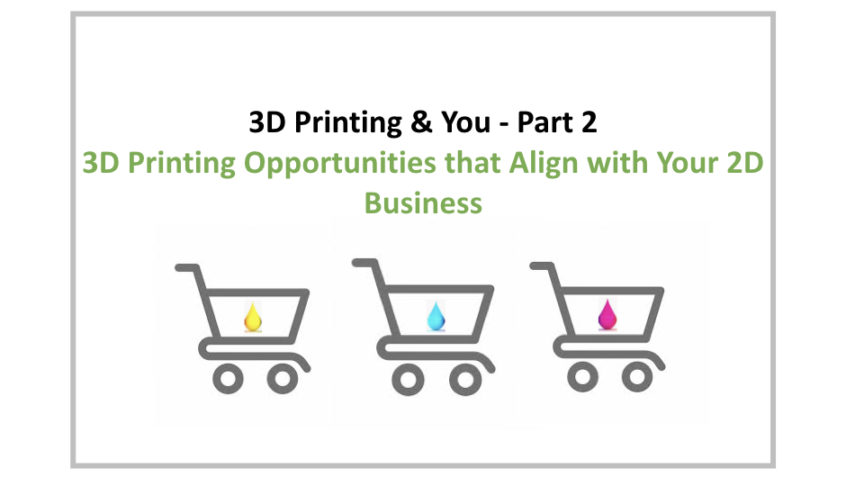I hope that my previous post opened your eyes to the uses of 3D Printing that are all around us, and some of the ways it can help inside a production print organization. Today, I want to look at opportunities to use 3D printing to drive business.
Very few printing companies are in a market today where buyers will look to them for 3D printed finished goods. At least, on the surface that appears to be the case. But, ask yourself this:
- Are you using inkjet wide-format printers to create signage? How about adding another dimension to the sign with custom, short-run, revenue generating appliques?
- Do you have the printing contract for a large venue that is used for conferences and sporting events? See the frustration your client has finding a source for the hallway statuary and models that their customers want? Then 3D printing with four-color material jetting technology may be your entry into another market – one that is short-run, short-lived, and totally custom – and offers higher revenue and margins.
- Do you own a package printing company? 3D printing enables quick mock-ups of the contents of the package, ranging from high-end beauty products to sophisticated consumer electronics.
- Are you a textile printing company? Take the personalization enabled by ink jetting onto fabric a step further with unique, 3D printed fasteners and accessories.
- Is your business a direct mail provider? Segmenting the list so your client’s high dollar prospects receive high quality, inkjet printed images is obvious, so add more value with unique, metal 3D printed gifts or memorabilia.
3D Printing in a 2D Printing World Won’t Be Easy
Few things worth doing are easy and 3D printing is one of them. But, when you think about it, the same could be said for running and growing a successful printing company.
Among the areas to consider when evaluating your 3D printing opportunity, both within the company and as a product line, are:
- Software – Do you have access to the computer aided design (CAD) software used to create most 3D printable files?
- Personnel – Do you have people who are or can become proficient in CAD software? Do you have talented operators looking for something different who can learn 3D printing?
- Engineering/Maintenance – Do you have inventive staff who can modify your existing equipment to produce new products – and repair the equipment – with 3D printing?
- Marketing – Do your marketing people focus on your current printing projects or do they look for opportunities to expand into adjacent markets?
- Sales – How will you motivate and compensate your salespeople during what could be long education and sales cycles?
- Management – Are you willing to develop an in-depth understanding of 3D printing’s potential for your business and your clients, today and in the near future?
To Buy or Not to Buy, That Is the Question
The purchase of an inkjet press is a decision not made lightly. Owners and managers rightly fret about whether a purchase is the right thing to do. Is the quality there? Is the productivity there? Is the market there? Are the margins there? And, for many printing companies, the cash to buy an inkjet press comes right out of the owner’s wallet.
The same concerns hold true with 3D printing. But you do have an option: 3D print service bureaus. These bureaus typically have a variety of 3D printing technology and printers on site, along with experienced personnel who know how to convert client files into ones that are actually printable. And just as sometimes a bit of operator finesse is needed to get an inkjet press to exceed offset print quality, 3D print service bureaus have operators who know the quirks of their printers.
Invest in a simple material extrusion printer for prototypes, jigs, fixtures and modifications to your equipment. But let an expert handle the complex 3D print jobs until you are ready to make the investment necessary to bring them in-house.
Don’t Be Misled
Misconceptions about 3D printing’s capabilities lull many printing companies into a false sense of security. They consider the idea of “3D printing” and automatically assume it is only for finished goods. They think that because they apparently do not have a market for saleable 3D printed items that 3D printing is not for them.
Don’t let misconceptions deter you from evaluating 3D printing within your 2D printing business. We’re here to facilitate your exploration of the 3D printing opportunities and uses that are right for your business.

